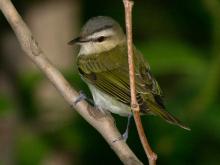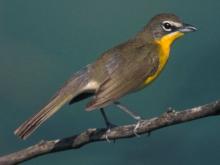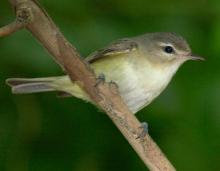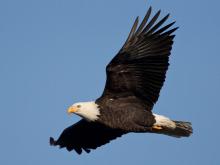Birds
Media

Species Types
Scientific Name
Vireo olivaceus
Description
Singing an incessant series of question-and-answer homilies from dawn to dusk, even through the hottest of summer days, the red-eyed vireo has been called the “preacher bird.”
Species Types
Scientific Name
Vireo flavifrons
Description
While most vireos are drab, the yellow-throated vireo boasts a bright yellow breast, throat, and spectacles. Look for it in places with mature trees.
Media

Species Types
Scientific Name
Setophaga americana (formerly Parula americana)
Description
The northern parula is a small summer resident warbler with gray-blue upperparts, two white wingbars, and a greenish-yellow patch on the back. The male has black and chestnut bands on the yellow breast.
Media

Species Types
Scientific Name
Icteria virens
Description
Our largest warbler, the yellow-breasted chat utters a wide variety of mews, chats, whistles, and stutters. Look for singing males during breeding season. Other times, they hide successfully in brambles and thickets.
Media

Species Types
Scientific Name
Setophaga dominica (formerly Dendroica dominica)
Description
The yellow-throated warbler creeps along branches high in the tops of trees, searching the bark for insects. Listen for its distinctive song, a cascade of clearly whistled tew notes.
Media

Species Types
Scientific Name
Vireo griseus
Description
The white-eyed vireo’s white irises would seem its most distinctive feature, but it’s actually better known for its distinctive, loud, vociferous song.
Media

Species Types
Scientific Name
Vireo gilvus
Description
The warbling vireo is a drab little bird with a colorful, brilliant song. It’s a common summer resident. Listen for it in forests, woodlands, and suburbs, especially in large trees near water.
Media

Species Types
Scientific Name
Coccothraustes vespertinus
Description
Evening grosbeaks are sporadically present in Missouri — flocks sometimes wander here from the north during winter. When flocks appear at backyard birdfeeders, it creates a local sensation.
Media

Species Types
Scientific Name
Haliaeetus leucocephalus
Description
Our national symbol, the mature bald eagle is unmistakable with its dark brown body, yellow bill, and white head and tail. It soars with wings held flat and can have a 7-foot wingspan.
Media

Species Types
Scientific Name
Setophaga coronata (formerly Dendroica coronata)
Description
The yellow-rumped warbler is Missouri’s most abundant migrant warbler. It is also seen in winter. Adults have a yellow patch on the rump, the crown, and the sides near the bend of the wing.
See Also







Media

Species Types
Scientific Name
Hemaris diffinis
Description
The snowberry clearwing is a moth that confuses people because it looks like a bumblebee and flies like a hummingbird!
Media

Species Types
Scientific Name
Hyles lineata
Description
The white-lined sphinx moth sometimes confuses people because it flies, hovers, and eats from flowers like a hummingbird. The adults often fly during daylight hours as well as in the night and are often found at lights.
Media

Species Types
Scientific Name
Darapsa myron
Description
The Virginia creeper sphinx moth is common in woods and brushy areas and comes to lights at night. The larvae eat Virginia creeper and grape leaves.
Media

Species Types
Scientific Name
Perimyotis subflavus (formerly Pipistrellus subflavus)
Description
Tri-colored bats, formerly called eastern pipistrelles, are relatively small and look pale yellowish or pale reddish brown. The main hairs are dark gray at the base, broadly banded with yellowish brown, and tipped with dark brown.
Media

Species Types
Scientific Name
Myotis grisescens
Description
Gray myotises are difficult to distinguish from other mouse-eared bats. A key identifying feature of the gray myotis is that its wing is attached to the ankle and not at the base of the toes. It’s an endangered species.
Media

Species Types
Scientific Name
Myotis lucifugus
Description
The little brown myotis (little brown bat) is one of our most common bats, but populations are declining. White-nose syndrome has taken a heavy toll in northeastern states. This species is now listed as vulnerable across its range.
Media

Species Types
Scientific Name
Myotis sodalis
Description
The Indiana myotis, or Indiana bat, summers along streams and rivers in north Missouri, raising its young under the bark of certain trees. It is an endangered species.
About Birds in Missouri
About 350 species of birds are likely to be seen in Missouri, though nearly 400 have been recorded within our borders. Most people know a bird when they see one — it has feathers, wings, and a bill. Birds are warm-blooded, and most species can fly. Many migrate hundreds or thousands of miles. Birds lay hard-shelled eggs (often in a nest), and the parents care for the young. Many communicate with songs and calls.





















